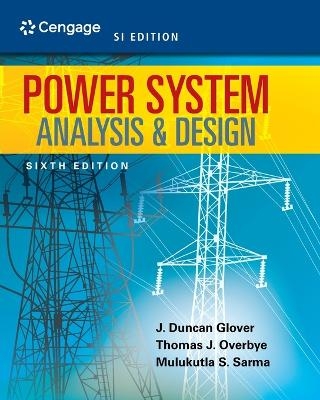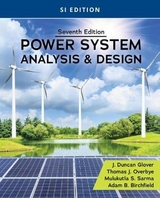
Power System Analysis and Design, SI Edition
CL Engineering (Verlag)
978-1-305-63618-7 (ISBN)
- Titel erscheint in neuer Auflage
- Artikel merken
Dr. J. Duncan Glover is president and principal engineer at Failure Electrical, LLC. He earned his Ph.D. from MIT. Dr. Glover has served as principal engineer at Exponent Failure Analysis Associates and was a tenured associate professor in the electrical and computer engineering department of Northeastern University. Dr. Glover has held several engineering positions with leading companies, including the International Engineering Company and the American Electric Power Service Corporation. He specializes in issues pertaining to electrical engineering, particularly as they relate to failure analysis of electrical systems, subsystems and components, including causes of electrical fires. Dr. J. Duncan Glover is president and principal engineer at Failure Electrical, LLC. He earned his Ph.D. from MIT. Dr. Glover has served as principal engineer at Exponent Failure Analysis Associates and was a tenured associate professor in the electrical and computer engineering department of Northeastern University. Dr. Glover has held several engineering positions with leading companies, including the International Engineering Company and the American Electric Power Service Corporation. He specializes in issues pertaining to electrical engineering, particularly as they relate to failure analysis of electrical systems, subsystems and components, including causes of electrical fires. Dr. Tom Overbye serves as professor and holder of the O’Donnell Foundation Chair III in the Department of Electrical and Computer Engineering at Texas A&M University. He earned his Ph.D. from the University of Wisconsin. Prior to joining Texas A&M in 2017, he was a professor for 25 years at the University of Illinois. Before entering academia, Dr. Overbye worked at Madison Gas and Electric Company. He is also the primary developer of the PowerWorld® Simulator computer package and is a founder of PowerWorld Corporation. Dr. Overbye has received several teaching and research honors, including the BP Amoco Award for Innovation in Undergraduate Education, a University of Wisconsin-Madison College of Engineering Distinguished Achievement Award and the 2011 IEEE Power and Energy Society Outstanding Engineering Educator Award. He is also a member of the US National Academy of Engineering. His primary interest lies in the area of power and energy systems. A forerunner in his field, Dr. Mulukutla S. Sarma has written not only this text, but also numerous technical articles for leading journals, including the first studies of methods for computer-aided analysis of three-dimensional nonlinear electromagnetic field problems as applied to the design of electrical machinery. Dr. Sarma is a life-fellow of IEEE (U.S.A), a fellow of IEEE (U.K.) and IEEE (India), a reviewer of several IEEE Transactions, a member of the IEEE Rotating Machinery Committee and a member of several other professional societies. He is also a professional engineer in the State of Massachusetts.
1. INTRODUCTION.
Case Study: How the Free Market Rocked the Grid. History of Electric Power Systems. Present and Future Trends. Electric Utility Industry Structure. Computers in Power System Engineering. PowerWorld Simulator.
2. FUNDAMENTALS.
Case Study: Key Connections (Microgrids). Phasors. Instantaneous Power in Single-Phase AC Circuits. Complex Power. Network Equations. Balanced Three-Phase Circuits. Power in Balanced Three-Phase Circuits. Advantages of Balanced Three-Phase vs. Single-Phase Systems.
3. POWER TRANSFORMERS.
Case Study: Power Transformer – Life Management and Extension. The Ideal Transformer. Equivalent Circuits for Practical Transformers. The Per-Unit System. Three-Phase Transformer Connections and Phase Shift. Per-Unit Equivalent Circuits of Balanced Three-Phase Two-Winding Transformers. Three-Winding Transformers. Autotransformers. Transformers with Off-Nominal Turns Ratios.
4. TRANSMISSION-LINE PARAMETERS.
Case Study: Integrating North America's Power Grid. Case Study: Grid Congestion. Resistance. Transmission Line Design Considerations. Resistance. Conductance. Inductance: Solid Cylindrical Conductor. Inductance: Single-Phase Two-Wire Line and Three-Phase Three-Wire Line with Equal Phase Spacing. Inductance: Composite Conductors, Unequal Phase Spacing, Bundled Conductors. Series Impedances: Three-Phase Line with Neutral Conductors and Earth Return. Electric Field and Voltage: Solid Cylindrical Conductor. Capacitance: Single-Phase Two-Wire Line and Three-Phase Three-Wire Line with Equal Phase Spacing. Capacitance: Stranded Conductors, Unequal Phase Spacing, Bundled Conductors. Shunt Admittances: Lines with Neutral Conductors and Earth Return. Electric Field Strength at Conductor Surfaces and at Ground Level. Parallel Circuit Three-Phase Lines.
5. TRANSMISSION LINES: STEADY-STATE OPERATION.
Case Study: The ABC's of HVDC Transmission Technologies. Medium and Short Line Approximations. Transmission-Line Differential Equations. Equivalent ? Circuit. Lossless Lines. Maximum Power Flow. Line Loadability. Reactive Compensation Techniques.
6. POWER FLOWS.
Case Study: Finding Flexibility: Cycling the Conventional Fleet. Direct Solutions to Linear Algebraic Equations: Gauss Elimination. Iterative Solutions to Linear Algebraic Equations: Jacobi and Gauss-Seidel. Iterative Solutions to Nonlinear Algebraic Equations: Newton-Raphson. The Power Flow Problem. Power Flow Solution by Gauss-Seidel. Power Flow Solution by Newton-Raphson. Control of Power Flow. Sparsity Techniques. Fast Decoupled Power Flow. The "DC" Power Flow. Economic Dispatch. Optimal Power Flow. Design Projects.
7. SYMMETRICAL FAULTS.
Case Study: Short-Circuit Modeling of a Wind Power Plant. Series R-L Circuit Transients. Three-Phase Short Circuit – Unloaded Synchronous Machine. Power System Three-Phase Short Circuits. Bus Impedance Matrix. Circuit Breaker and Fuse Selection. Design Project.
8. SYMMETRICAL COMPONENTS.
Case Study: Technological Progress in High-Voltage Gas-Insulated Substations of Symmetrical Components. Definition of Symmetrical Components. Sequence Networks of Impedance Loads. Sequence Networks of Series Impedances. Sequence Networks of Three-Phase Lines. Sequence Networks of Rotating Machines. Per-Unit Sequence Models of Three-Phase Two-Winding Transformers. Per-Unit Sequence Models of Three-Phase Three-Winding Transformers. Power in Sequence Networks.
9. UNSYMMETRICAL FAULTS.
Case Study: Innovative Medium Voltage (MV) Switchgear for Today's Applications. System Representation. Single Line-to-Ground Fault. Line-to-Line Fault. Double Line-to-Ground Fault. Sequence Bus Impedance Matrices. Design Projects.
10. SYSTEM PROTECTION.
Case Study: Upgrading Relay Protection. System Protection Components. Instrument Transformers. Overcurrent Relays. Radial System Protection. Reclosers and Fuses. Directional Relays. Protection of Two-Source System with Directional Relays. Zones of Protection. Line Protection with Impedance (Distance) Relays. Diffe
| Erscheinungsdatum | 19.08.2016 |
|---|---|
| Sprache | englisch |
| Maße | 183 x 41 mm |
| Gewicht | 1316 g |
| Themenwelt | Mathematik / Informatik ► Informatik ► Theorie / Studium |
| Technik ► Elektrotechnik / Energietechnik | |
| ISBN-10 | 1-305-63618-X / 130563618X |
| ISBN-13 | 978-1-305-63618-7 / 9781305636187 |
| Zustand | Neuware |
| Haben Sie eine Frage zum Produkt? |
aus dem Bereich



